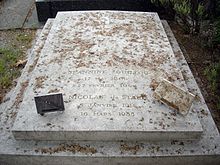Nicolas de Staël
Nicolas de Staël | |
|---|---|
| Born | Nikolai Vladimirovich Stael von Holstein 5 January 1914 |
| Died | 16 March 1955 (aged 41) Antibes, France |
| Known for | Painting, Drawing |
| Spouse | Françoise Chapouton |
| Partner | Jeannine Guillou |
Nicolas de Staël (French: . He also worked with collage, illustration and textiles.
Early life
Nicolas de Staël was born Nikolai Vladimirovich Stael von Holstein (
Career beginnings
He eventually studied decoration and design at the Brussels
During the War
In 1941, he moved to Nice where he met Jean Arp, Sonia Delaunay and Robert Delaunay, and these artists would inspire his first abstract paintings, or "Compositions". In 1942, Jeannine and Nicolas de Staël's daughter Anne was born. The growing family also included Jeannine's nine-year-old son Antoine.[3] In 1943 (during the Nazi occupation), de Staël returned to Paris with Jeannine, but the war years were extremely difficult. During the war his paintings were included in several group exhibitions and in 1944 he had his first one-man exhibition at the Galerie l'Esquisse. In April 1945, he had a one-man exhibition at the Galerie Jeanne Bucher and in May 1945 his paintings were included in the first Salon de Mai.[3] De Staël's work was also included in the Salon d'Automne that year.[4] In Paris in 1944, he met and befriended Georges Braque, and by 1945 his exhibitions brought him critical fame. However times were difficult, and successes came too late, since Jeannine died in February 1946 from illness brought on by malnutrition.[5]
Professional success
De Staël met Françoise Chapouton in the spring of 1946, and they married in May. In October 1946 thanks to his friendship with artist
After returning to Paris, de Staël met visiting New York art dealer
In the fall of 1954, he moved with his family to Antibes.
Death
By 1953, de Staël's state led him to seek isolation in the south of France (eventually in Antibes). He suffered from exhaustion, insomnia and
Nicolas de Staël is buried at the Montrouge Cemetery.
Legacy
De Staël's painting career spans roughly 15 years (from 1940) and produced more than a thousand paintings. His work shows the influence of

De Staël's work was quickly recognized within the post-war art world, and he became one of the most influential artists of the 1950s. However, he moved away from abstraction in his later paintings, seeking a more "French" lyrical style, returning to representation (seascapes, footballers, jazz musicians, seagulls) at the end of his life. His return to imagery during the early 1950s can be seen as an influential precedent for the American Bay Area Figurative Movement, as many of those abstract painters made a similar move; returning to imagery during the mid-1950s. His painting style is characterized by a thick impasto showing traces of the brush and the palette knife, and by a division of the canvas into numerous zones of color (especially blues, reds and whites). His most well-known late paintings of beaches and landscapes are dominated by the sky and effects of light.[15]
Much of de Staël's late work—in particular his thinned and diluted oil on canvas abstract landscapes of the mid-1950s—predicts
The French New Wave filmmaker
De Staël's 1955 painting Le Fort d'Antibes was used as the cover for the Moody Blues' 1988 album Sur la Mer.[16]
See also
- School of Paris
- Tachisme
- Lyrical Abstraction
References
- ^ In France, Staël is pronounced [stal]. In Switzerland, it is also pronounced [stɛl]. It is never pronounced [sta.ɛl].
- ISBN 1884446000.
- ^ a b c d Chronology: Exhibition Catalogue, Nicolas de Staël, paintings 1950–1955, Mitchell-Innes & Nash, NYC. 1997 p.96
- ^ Douglas Cooper, Nicolas de Staël, Masters and Movements, Weidenfeld and Nicolson Ltd. London, 1961, p. 21
- ^ Douglas Cooper, Nicolas de Staël, Masters and Movements, Weidenfeld and Nicolson Ltd. London, 1961, pp. 23–24
- ^ a b Chronology: Exhibition Catalogue, Nicolas de Staël, paintings 1950–1955, Mitchell-Innes & Nash, NYC. 1997 pp.96–97
- ^ a b Chronology: Exhibition Catalogue, Nicolas de Staël, paintings 1950–1955, Mitchell-Innes & Nash, NYC. 1997 p.98
- ^ Eliza Rathbone, Introduction: Nicolas de Staël, 1914–1955, Exhibition Catalogue, Mitchell-Innes & Nash, NYC. 1997 p.6
- ^ Chronology: Exhibition Catalogue, Nicolas de Staël, paintings 1950–1955, Mitchell-Innes & Nash, NYC. 1997 p.97–98
- ^ Richardson, J.(2001) The Sorcerers Apprentice, London: Pimlico p195
- ^ Douglas Cooper, Nicolas de Staël, Masters and Movements, Weidenfeld and Nicolson Ltd. London, 1961, p.6
- ^ Chronology: Exhibition Catalogue, Nicolas de Staël, paintings 1950–1955, Mitchell-Innes & Nash, NYC. 1997 p.99
- ^ James E.B. Breslin, Mark Rothko. A Biography. Chicago, 1993: p. 621
- ^ Dario Gamboni, Potential Images. Ambiguity and Indeterminacy in Modern Art. 2002, New Haven, p.19
- ^ Landscape Study, Tate
- ^ "The Moody Blues Frequently Asked Questions List".
Sources
- Exhibition Catalogue, Nicolas de Staël, paintings 1950–1955, Mitchell-Innes & Nash, NYC. 1997, ISBN 0-9660769-1-5.
- Douglas Cooper, Nicolas de Staël, Masters and Movements, Weidenfeld and Nicolson Ltd. London, 1961.
- Lefevre Fine Art, Thomas Gibson Fine Art, "Works on Paper" Nicolas de Staël, "Sans Titre", page 60
External links
- Pompidou Center show, in French
- artcyclopedia entry
- Nicolas de Staël, in French museums
- Nicolas de Staël biography on Applicat-Prazan



